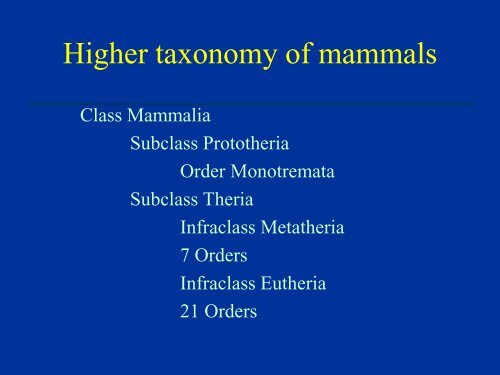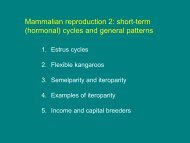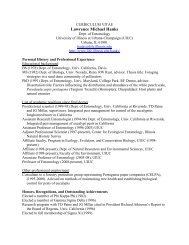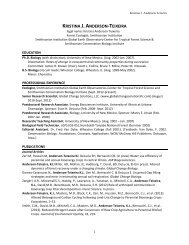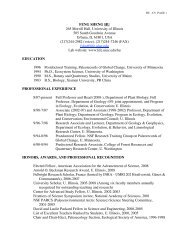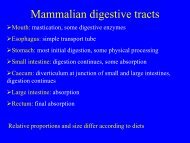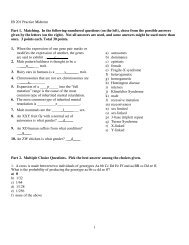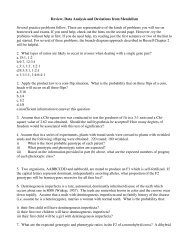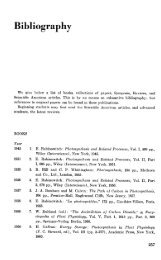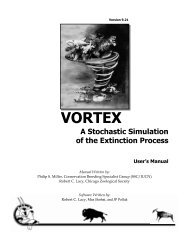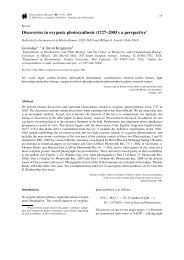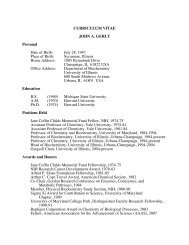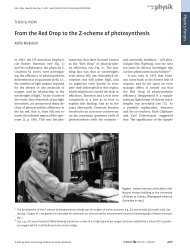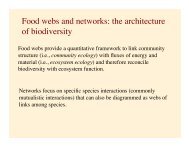Higher taxonomy of mammals
Higher taxonomy of mammals
Higher taxonomy of mammals
Create successful ePaper yourself
Turn your PDF publications into a flip-book with our unique Google optimized e-Paper software.
<strong>Higher</strong> <strong>taxonomy</strong> <strong>of</strong> <strong>mammals</strong><br />
Class Mammalia<br />
Subclass Prototheria<br />
Order Monotremata<br />
Subclass Theria<br />
Infraclass Metatheria<br />
7 Orders<br />
Infraclass Eutheria<br />
21 Orders
Tachyglossidae<br />
Order Monotremata<br />
Tachyglossus<br />
Zaglossus<br />
Ornithorhynchidae<br />
Ornithorhynchus
Monotremes are very different from other <strong>mammals</strong><br />
• Lay eggs<br />
• No nipples for lactation<br />
• Teeth absent (except juvenile platypus)<br />
• Electrosenory ability in bills and beaks<br />
• No auditory bullae; cochlea <strong>of</strong> inner ear curved, not<br />
coiled<br />
• Shoulder girdle retains primitive structure with rigid<br />
connections between shoulders and sternum<br />
• Epipubic bones<br />
• Cervical ribs<br />
• Males with ankle spurs and poison glands
• Bifid Uteri<br />
Metatheria vs Eutheria<br />
• Birth through<br />
pseudovaginal canal<br />
• Bifid Penis<br />
• Anterior scrotum<br />
• Very altricial young<br />
• Marsupium or pouch<br />
(most but not all!)<br />
• Fused Uteri<br />
• Birth through vaginal<br />
canal<br />
• Non-Bifid penis<br />
• Posterior scrotum<br />
• Precocial or<br />
moderately altricial<br />
young<br />
• Development in uterus
• Fenestrated palate<br />
IDing Marsupials<br />
• Inflected angular processes<br />
• Number <strong>of</strong> upper incisors usually higher<br />
than lower incisors (Not in Vombatidae)<br />
• Premolars 3/3, molars 4/4 (primitive)<br />
• Relatively small braincase<br />
• Epipubic bones
Orders <strong>of</strong> Marsupials<br />
• Didelphimorphia (S Am, N Am)<br />
• Microbiotheria (S Am)<br />
• Paucituberculata (S Am)<br />
• Dasyuromorphia (Aust)<br />
• Peramelemorphia (Aust)<br />
• Notoryctemorphia (Aust)<br />
• Diprotodontia (Aust)
• American opossums<br />
• One Family: Didelphidae<br />
• Range: US south through<br />
South America<br />
• Terrestrial, arboreal and<br />
semiaquatic<br />
• Only <strong>mammals</strong> with 5<br />
upper incisors<br />
Didelphimorphia<br />
Marmosa murina<br />
Didelphis virginiana
• Monito del monte<br />
• One family:<br />
Microbiotheriidae<br />
• One living species:<br />
Dromiciops gliroides<br />
• Range: South-Central<br />
Chile<br />
• Arboreal, possum-like<br />
Microbiotheria<br />
Dromiciops gliroides
• Shrew-opossums<br />
• One family:<br />
Caenolestidae<br />
• Range: western South<br />
America, mostly in<br />
Andes<br />
• Terrestrial,<br />
insectivorous<br />
Paucituberculata<br />
Rhyncholestes raphanurus
Dasyuromorphia<br />
• Marsupial Carnivores<br />
• Three Families:<br />
Dasyuridae: Range <strong>of</strong> carnivores; includes<br />
quolls, Tasmanian devils, dibblers<br />
Myrmecobiidae: termite-eating numbat<br />
Thylacinidae: Tasmanian wolf; extinct<br />
• Range: Australia, Tasmania, New Guinea<br />
• Unique 4/3 incisors
Dasyuridae<br />
Dasyuromorphia<br />
Tiger quoll<br />
Dasyurus maculatus<br />
Tasmanian devil<br />
Southern dibbler<br />
Parantechinus apicalis<br />
Sarcophilus harrisii
Thylacinidae<br />
Tasmanian wolf<br />
Thylacinus cynocephalus<br />
Myrmecobiidae<br />
Numbat<br />
Myrmecobius fasciatus
• Bandicoots and bilbies<br />
• Three Families:<br />
– Thylacomyidae: bilbies<br />
– Peramelidae: bandicoots<br />
Peramelemorphia<br />
– Chaeropodidae: pig-footed<br />
bandicoot (extinct)<br />
• Range: Australia,<br />
Tasmania, New Guinea<br />
• Polyprotodont<br />
• Chorioallantoic placenta<br />
Northern Brown Bandicoot<br />
Isoodon macrourus<br />
Greater bilby<br />
Macrotis lagotis
• Marsupial moles<br />
• One family:<br />
Notoryctidae<br />
• Range: Central and<br />
Western Australia<br />
• Fossorial, live in<br />
deserts<br />
• Very large, spade-like<br />
claws<br />
Notoryctemorphia<br />
Notoryctes typhlops
Diprotodontia<br />
• Largest Order <strong>of</strong> Marsupials<br />
• 11 Families:<br />
– Phascolarctidae: koalas<br />
– Vombatidae: wombats<br />
– Phalangeridae: brushtail possums and cuscuses<br />
– Burramyidae: pygmy possums<br />
– Pseudocheiridae: ringtailed possums, greater glider<br />
– Petauridae: gliders, striped and Leadbeater’s possums<br />
– Tarsipedidae: honey possum or noolbenger<br />
– Acrobatidae: feathertail glider and possum<br />
– Hypsoprymnodontidae: musky rat kangaroo<br />
– Potoroidae: bettongs, potoroos, rat kangaroos<br />
– Macropodidae: kangaroos and wallabies
Diprotodontia<br />
• Named for single pair <strong>of</strong> lower incisors<br />
• Large range <strong>of</strong> sizes from small possums to<br />
the larger kangaroos<br />
• Terrestrial, semifossorial, and arboreal<br />
• Range: Australia, Tasmania, New Guinea,<br />
Indonesia
Diprotodontia<br />
Phascolarctidae Vombatidae<br />
Koala<br />
Phascolarctos cinereus<br />
Northern hairy-nosed<br />
wombat<br />
Lasiorhinus krefftii<br />
Vombatus ursinus
Phalangeridae<br />
Common brushtail<br />
Trichosurus vulpecula<br />
Diprotodontia<br />
Cuscus<br />
Phalanger<br />
Burramyidae<br />
Mountain pygmy possum<br />
Burramys parvus
Common ringtail<br />
Pseudocheirus peregrinus<br />
Diprotodontia<br />
Pseudocheiridae<br />
Greater glider<br />
Petauroides volans
Sugar glider<br />
Petaurus breviceps<br />
Diprotodontia<br />
Petauridae<br />
Striped possum<br />
Dactylopsila trivirgata<br />
Leadbeater’s Possum<br />
Gymnobelideus leadbeateri
Feather-tail glider<br />
Acrobates pygmaeus<br />
Diprotodontia<br />
Acrobatidae Tarsipedidae<br />
Noolbenger<br />
Tarsipes rostratus
Potoroidae<br />
Long-footed potoroo<br />
Potorus longipes<br />
Diprotodontia<br />
Burrowing bettong<br />
Bettongia lesueur<br />
Hypsiprymnodontidae<br />
Musky rat kangaroo<br />
Hypsiprymnodon moschatus
Gray kangaroo<br />
Macropus giganteus<br />
Yellow-footed rock<br />
wallaby<br />
Petrogale xanthopus<br />
Diprotodontia<br />
Macropodidae<br />
Lumholtz tree kangaroo<br />
Dendrolagus lumholtzi


